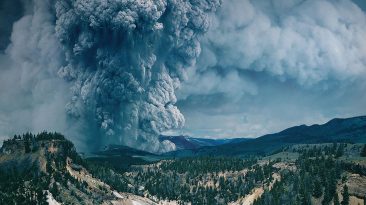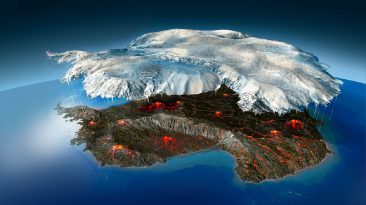Millions of years ago, all the continents were one. Waiting to crack and spread into the world we know today. Thing is, Earth’s ground is constantly moving. So how about we fast forward and bring two of them back together? South America and Africa. If these two landmasses fused together, how disastrous would that be? What new animal species would it create? And why would this union be more of a reunion?
300 million years ago, there was just one continent on our planet. Pangea. But this supercontinent was not meant to last. That’s because the rigid outermost shell of Earth’s crust, the lithosphere, is broken up into several plates. These plates are floating on top of the mantle, which means that they can move. And they do.
As a result of the mantle shifting, Pangea broke up in phases. From these pieces, several smaller supercontinents were formed, only to eventually also break apart. One of them was Gondwana, some of which was what we now know as Africa and South America. This massive landmass was covered in rainforests during the time when dinosaurs still roamed the globe.
But its division started when these future regular continents started to drift apart. When this all ended, the South Atlantic Ocean stood between them. But hold on. Since these plates continue to move, there’s a possibility these two continents will meet again. Of course, you don’t have a couple hundred million years to see this happen. So let’s fast-track it.
If you lived to see these two continents merge, what would this epic reunion look like? Normally, continents move at a speed of 1.5 cm (0.6 in) a year. Assuming Africa and South America met halfway in the South Atlantic Ocean, it would take them 230 million years to join. So let’s say the mantle beneath them was especially restless due to unprecedented circumstances on our planet.
This would violently shake the plates of these two continents and push them toward each other. Even if they only traveled about as fast as us humans tend to walk, merely a speed of 1.3 m/s (4.3 ft/s), Africa and South America would reunite in around 30 days. Sure, it’d be quite the shaky journey, literally causing massive earthquakes on both continents. And month-long earthquakes aren’t fun. But that’s a fair price to witness the formation of Afrimerica.
It might not be the most clever of names, but it’ll do for now. This supercontinent would automatically become the largest in the world, 1.5 times bigger than Asia. Countries making the cross-ocean move would have to deal with new neighbors. Nigeria and Cameroon would now border Brazil. Uruguay would be side by side with Angola, while Argentina would border South Africa.
A brand new mountain range would form between the two sections of Afrimerica. This would provide a natural border between nations, which might help ease potential tensions about land distribution. Unfortunately, such elevations can take many millions of years to form. It looks like countries would have to resort to diplomacy to figure out their borders.
Just imagine living in Brazil. Sure, you’d experience an influx of cultures and a potential boom in tourism. But on the other hand, I’d box away most of your swimwear. All of the country’s coastal regions would cease to exist, which would bring an end to the beach culture that is integral to its lifestyle. Afrimerica would also be quite the exporter of goods.
South America alone produces and sells a vast array of foods, from sugar to bananas, beef and corn. Add to that fuel and raw materials. On its own, Africa exports textiles and clothing, as well as all things related to petroleum. But let’s not forget that it supports the second-largest mineral industry in the world. And with renewable energy on the rise, many of these minerals, like copper and nickel, would grow in demand.
But then there’s the issue of animal migration. With no mountains in their way, species unique to each continent could spread into new territories. Camp in the Amazon forest, and you could cross paths with an African elephant, a hippopotamus or a spotted hyena. Open your window in Nigeria and you could spot a sloth, a capybara or even a giant anteater in your garden.
Of course, you’d also come across unusual plants and insects. If you are a nature freak this crossover might sound exciting, but it would be nothing but bad news for regional ecosystems. The newly arrived species would become predators, competitors and parasites of native plants and animals. Not to mention possible disease spreaders. All of that would threaten biodiversity.
It would take a long time before a new equilibrium is found in the bordering regions. Once things were settled, some species might interbreed and new animal hybrids could emerge. We already have leopons, ligers and beefalos. We could see more of those, but that would take thousands of years. On a more positive note, Afrimerica might host a great cultural reunion to go along with its geographical re-connection.
After all, there is already a shared connection between the two continents. Going back as far as the early 1500s, many of the enslaved Africans were forcefully removed from African countries and transported to South America. Like it happened then, the meeting of the two continents would spur a cultural exchange. Oh, and don’t forget the languages. New tongues could emerge with time, such as a mix of Zulu and Spanish in Argentina.
But let’s go back to those month-long earthquakes. If they are the only thing that would create Afrimerica, perhaps there could be very little left to reunite. And that’s barring the possibility of the tremors going on for way, way longer. I’m talking about a full year.
Sources
- “Pangaea With Current International Borders”. 2015. brilliantmaps.com.
- “What Is Tectonic Shift?”. 2022. oceanservice.noaa.gov.
- “Artefact – Brazilian Beach Culture”. Nicole Gheller. 2022. artefactmagazine.com.
- “South America – Trade”. 2022. britannica.com.
- “Which Are African Economies’ Biggest Exports?”. 2016. weforum.org.



























